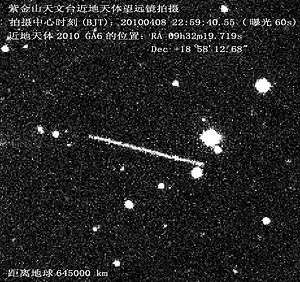2010 GA6
|
2010 GA6, captured by Purple Mountain Observatory in April 8, 2010 | |
| Discovery[1] | |
|---|---|
| Discovered by | Catalina Sky Survey |
| Discovery date | April 5, 2010 |
| Designations | |
| none | |
| Apollo, NEO[2] | |
| Orbital characteristics[2] | |
| Epoch 13 January 2016 (JD 2457400.5) | |
| Uncertainty parameter 6 | |
| Aphelion | 3.6810 AU (550.67 Gm) |
| Perihelion | 0.92946 AU (139.045 Gm) |
| 2.3052 AU (344.85 Gm) | |
| Eccentricity | 0.59681 |
| 3.50 yr (1278.4 d) | |
| 223.11° | |
| 0° 16m 53.76s /day | |
| Inclination | 9.7537° |
| 197.70° | |
| 34.309° | |
| Earth MOID | 0.0042487 AU (635,600 km) |
| Jupiter MOID | 1.35447 AU (202.626 Gm) |
| Physical characteristics | |
| Dimensions | 22 meters (72 ft)[3] |
| 25.9,[3] 26.0[2] | |
|
| |
2010 GA6 is an Apollo near-Earth asteroid discovered by the Catalina Sky Survey on April 5, 2010,[1] four days before a close approach to Earth. It is a relatively small space rock about 22 meters (72 ft) wide.[3] With a 1-day observation arc, the asteroid had a 1 in 6 million chance of impacting in 2074.[4] It was removed from the Sentry Risk Table on April 8, 2010.[5] The asteroid passed Earth at a distance of about 0.0029 AU (430,000 km; 270,000 mi) at 02:07 UT on April 9, 2010 (7:06 pm EST on April 8).[3][6][7][8] A stony asteroid 22 meters in diameter can be expected to create an air burst with the equivalent of 300 kilotons of TNT at an altitude of 21 kilometers (69,000 ft).[9] Generally only asteroids larger than 35 meters across pose a threat to a town or city.[10]
See also
References
- 1 2 "MPEC 2010-G23 : 2010 GA6". IAU Minor Planet Center. 2010-04-05. Retrieved 2013-02-08. (K10G06A)
- 1 2 3 "JPL Small-Body Database Browser: (2010 GA6)". Jet Propulsion Laboratory. Retrieved 31 March 2016.
- 1 2 3 4 "Asteroid to Fly by Within Moon's Orbit Thursday". NASA/JPL. April 6, 2010. Retrieved 2013-02-08.
- ↑ "Observations of small Solar-System bodies". hohmanntransfer. 2010-04-07. Retrieved 2013-02-08. (1.6e-07 = 1 in 6,250,000 chance)
- ↑ "Date/Time Removed". NASA/JPL Near-Earth Object Program Office. Retrieved 2012-03-19.
- ↑ "JPL Close-Approach Data: (2010 GA6)" (2013-01-20 last obs (arc=4 days)). Retrieved 2013-02-08.
- ↑ Newfound Asteroid to Buzz Earth Thursday
- ↑ Newly Discovered Asteroid Will Pass by Earth April 8
- ↑ Robert Marcus; H. Jay Melosh & Gareth Collins (2010). "Earth Impact Effects Program". Imperial College London / Purdue University. Retrieved 2013-02-04. (solution using 22 meters, 2600kg/m^3, 17km/s, 45 degrees)
- ↑ Will Ferguson (January 22, 2013). "Asteroid Hunter Gives an Update on the Threat of Near-Earth Objects". Scientific American. Retrieved 2013-01-23.
External links
- 2010 GA6 via JPL's small body database browser
- 2010 GA6 at Harvard University's Minor Planet Center
- 2010 GA6 at the JPL Small-Body Database

